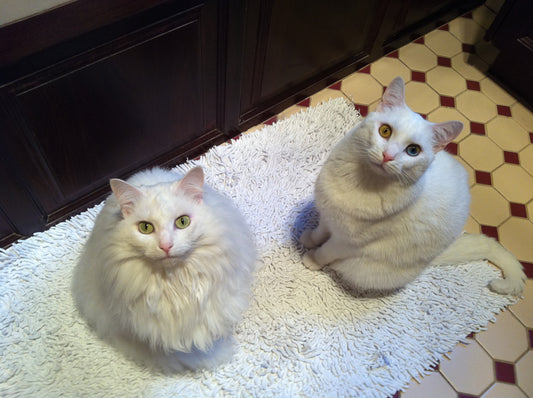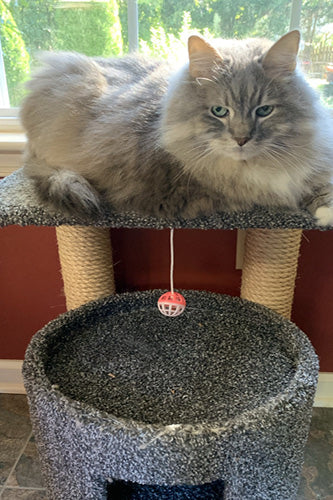There is literally nothing better in the world than snuggling into your cat's fur. It lifts every mood, fixes every woe, and hopefully, your furry friend feels the same about your cuddles. But have you ever thought about the health of that snuggly, silky coat and how your cat's skin health is linked to their coat health? Let’s get the low-down on all things cat fluff.
Why Is Cats Skin So Important - Skin 101
Your cat’s skin is the biggest organ in their body, making up to a quarter of their body weight. In combination with their fur, it plays a vital role in temperature regulation. And, of course, it contains all the hair follicles for that fluffy coat, as well as the specialised sensory cells for whiskers.
The anatomy of your cat’s skin
 The Subcutis
The Subcutis
This is the innermost layer of the skin, known as the subcutis. It’s made up of subcutaneous fat and muscle, with several important functions: providing insulation, acting as a shock absorber, and storing fluids, energy, and electrolytes.
The Dermis
The middle layer, known as the dermis, provides structural support and nourishment to the outer layer of the skin. It contains blood vessels that supply the outer layer and play a crucial role in regulating your cat's temperature. The dermis also houses nerves that respond to sensations like pain, heat, cold, and irritation.
Hair follicles originate in this layer and grow through pores in the outer dermal layer.
The EpidermisThe outermost layer of the skin, the bit we can see under the fur, is called the epidermis. It’s your cat’s first line of defence against the world, preventing foreign substances from entering the body and reducing water loss.
The epidermis is composed of various cell types, each with specific functions: producing skin and hair pigmentation, contributing to the immune system, providing sensory information (such as through whiskers), and generating new skin cells. The rate at which skin cells are shed and replaced can be influenced by factors like nutrition, disease, hormones, immune responses, inflammation, genetics, and medications.
Fur Facts
Your cat is super proud of their coat. In fact, they spend up to 50% of their day grooming it. A healthy coat is vital to their health as it helps protect them from external allergens and injury from their environment; it protects them from UV damage and helps regulate their body temperature, both throughout the day and seasonally.
Your cat’s coat is made up of compound hairs. These are a central hair surrounded by 3-15 smaller hairs, all coming from the same skin pore. On average, adult cats have around 130,000 hairs.
Kittens appear to be super fluffy, with a much finer coat when they are little, because their skin produces “simple” hairs, just a single hair from each pore. These gradually develop into compound hairs as they grow older.
We all love to see a sleek, shiny, healthy-looking coat, but it can be affected by a variety of things, from genetics to disease, medications, nutrition and environment. So, keeping it healthy isn’t as simple as giving it a quick brush.
Shedding in Spring
Cats shed their fur all year round, but this shedding peaks in spring in response to temperature and sunlight…so get that lint roller out because you’re going to get HAIRY!
4 Weird Cat Fur Facts
- Most calico (tortoiseshell) cats are female, and fully ginger/orange cats are male because these colours are genetically linked to their gender.
- Black-coated cats can go brown if their diet is poor and lacks tyrosine. The sun can also bleach black coats - so sun-worshipping black cats might look more brown during the spring and summer.
- Some breeds, like Turkish Van and Maine Coon have water-repellant coats. Does this mean they like water more than other breeds—the jury’s out on that one, but I can tell you my Maine Coon HATE water.
- When people say they’re allergic to cats, it’s not their fur that causes the allergic reaction. It's actually a reaction to proteins in the cats' saliva, urine and dander (dead flakes of shed skin). You can feed them a specially developed cat food that reduces this protein in your cat’s dander, making them less of an allergic risk!
Allergic Skin Disease in Spring
Although skin conditions aren’t as common in cats as they are in dogs, they can still suffer from issues with their skin, particularly in springtime when there are more allergens about. Think of it a bit like hay fever. Like us, cats can be allergic to things like grass and tree pollen and struggle with an increase in parasites like fleas during spring.
Healthy skin cells are like a solid wall, with cells tightly packed together like bricks and held in place by strong mortar. In contrast, skin affected by seasonal skin disease resembles a dry stone wall, where the cells are not as closely packed, and the mortar is weak. This allows water to escape from the skin, making it dry and flaky, while also letting allergens penetrate from the outside, triggering immune responses. In allergic skin disease or atopic dermatitis, the immune system overreacts, causing your cat to be itchy, uncomfortable and likely to overgroom.
You might notice your cat scratching, grooming themselves more often or more frantically, developing bald patches, or you could notice grainy, scab-like dandruff on their skin. This is known as Miliary dermatitis and often increases during spring and summer in response to allergens.
Seasonal Skin Conditions And The Effect On Cat Coat Health
Normal, healthy skin cells can maintain a beautiful, healthy coat. But if your cat is struggling with a seasonal skin condition, then their skin cells won’t be as strong and healthy and won’t be able to produce and maintain a gorgeous, sleek coat. So keeping skin healthy is important - even more so as we go into spring and they begin to shed.
Giving your cat a skin and coat supplement during spring means your cat will be more comfortable when the allergens are about. Try Antinol® Plus. It’s scientifically proven to reduce skin inflammation, support skin and coat health and even reduce shedding—for healthy, soothed skin and a shiny coat.
Other Things That Can Affect Your Cat’s Coat Shine
It’s not just seasonal issues that can result in your cat losing that sparkle and shine—a variety of underlying health conditions can also impact their coat health. So if you do notice a change to your pet’s coat, it’s important to get them checked out by your vet.
Here are a few conditions which might affect your cat’s fur:
Metabolic Disorders
These conditions can impact various body systems and often results in a dull, scruffy-looking coat.
Kidney Disease
Technically this is a metabolic disorder, but it’s so common in senior cats, that it needs its own mention. Cats with renal disease tend to have a dull, matted or greasy-looking coat.
Hormone conditions
The most common hormone condition in cats is hyperthyroidism which often results in a matted, greasy, unkempt coat and even hair loss.
Osteoarthritis
If your cat has joint pain and feels stiff they won’t be able to groom themselves properly—it’s just too uncomfortable to twist into those positions. So cats with arthritis tend to look more scruffy. They might also overgroom themselves around their painful joints in an attempt to relieve their discomfort, resulting in bald, sore patches.
5 tips to keep your cat’s skin and coat healthy
- Ensure they’re on a good quality diet that is balanced and high in omega-3s as these are vital in skin health.
- Groom them regularly. This prevents matting, helps to remove old, shed fur, and keeps the skin healthy.
- Keep your parasitic treatments up to date as fleas, ticks and mites increase in numbers during the spring, so they are more likely to have an allergic reaction.
- Give your cat a supplement to maintain their skin and coat health, especially during the spring and summer. Antinol is scientifically proven to reduce inflammation, which is particularly important if your cat is struggling with a seasonal skin allergy—helping reduce pain, inflammation and irritation. Plus, if your cat’s coat is suffering as a result of arthritis, Antinol is clinically proven to support joint health and reduce inflammation, keeping your cat active, mobile and able to reach all those tricky-to-groom spots!
- Minimise stress. When cats are stressed or anxious they tend to overgroom, causing bald patches, soreness and even secondary skin infections. You could try a pheromone plug-in to reduce stress. Check out our blog later this month for tips on reducing stress for your cat.
When should you start giving Antinol® to your cat with a seasonal skin allergy?
Start ASAP! But especially in the lead-up to spring. Giving your cat the higher loading dose as we enter spring will support them during a time of year when you might see flare-ups.


 Image by freepik
Image by freepik






